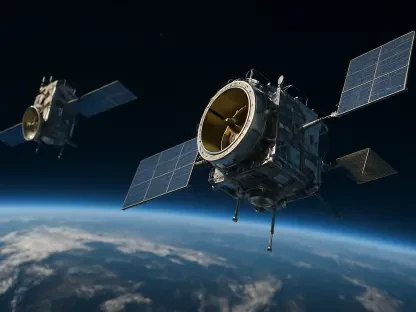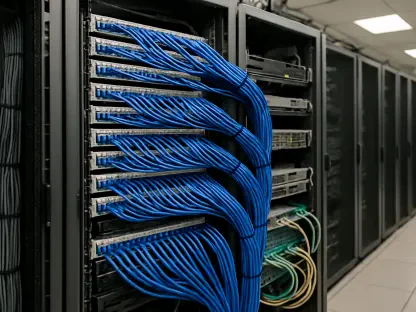In the relentless arena of modern warfare, where split-second decisions can determine the outcome of entire campaigns, technology has become the ultimate force multiplier, and among the most transformative innovations reshaping military tactics is edge computing—a decentralized method of processing data right at the source, rather than relying on far-off servers. This approach slashes delays, fortifies security, and ensures seamless communication even in the harshest, most disconnected environments. As battles increasingly hinge on real-time information and rapid response, edge computing emerges as a critical tool, offering militaries an unprecedented edge in operational efficiency and strategic dominance. This article explores how this cutting-edge technology is redefining battlefield dynamics, addressing the shortcomings of traditional systems, and positioning itself as a cornerstone of future combat strategies. From global adoption trends to localized innovations, the impact of edge computing is profound, promising to enhance mission success in ways previously unimaginable.
The stakes for adopting such advanced solutions have never been higher. Conventional data processing methods often falter under the chaotic conditions of conflict zones, where reliable connectivity is scarce and security risks loom large. Edge computing steps into this gap, delivering not just technological innovation but a lifeline for soldiers and commanders navigating high-pressure scenarios. By delving into its advantages, global trends, and specific applications, a clearer picture emerges of how this technology is poised to revolutionize military operations worldwide.
Overcoming the Shortcomings of Cloud-Based Systems
Traditional cloud computing, while a powerhouse in stable, connected environments, often stumbles when applied to the unpredictable nature of military operations. Its core design depends on centralized servers, meaning data must travel significant distances for processing, introducing latency that can be catastrophic in combat situations. On a battlefield, where immediate decisions can mean the difference between life and death, waiting even a few seconds for critical information is an unaffordable luxury. Furthermore, the prerequisite of constant, high-speed internet is rarely met in remote or hostile regions, rendering cloud systems unreliable when they are needed most. This connectivity bottleneck severely hampers the ability to execute timely and effective strategies, exposing a fundamental flaw in relying solely on such frameworks for military needs.
Security vulnerabilities compound the challenges of cloud computing in warfare contexts. Transmitting sensitive military data across expansive networks heightens the risk of interception by adversaries or exposure to sophisticated cyberattacks. A notable incident from 2024 in Ukraine, where hostile forces exploited cloud-connected webcams to target vital infrastructure, serves as a grim reminder of these dangers. Such breaches not only jeopardize missions but also undermine trust in centralized data systems. The combination of latency, connectivity issues, and security gaps makes it abundantly clear that alternative solutions are essential to meet the rigorous demands of modern military engagements, pushing the need for more robust, localized approaches to the forefront of strategic planning.
Edge Computing as a Tactical Game-Changer
Edge computing addresses the critical flaws of cloud systems by processing data directly at or near its point of origin, often through devices and sensors deployed in the field. This localized approach dramatically reduces latency, enabling near-instantaneous analysis and response—vital for scenarios like drone surveillance or coordinating rapid troop movements. Soldiers and commanders gain access to actionable insights without the delay of data traveling to and from distant servers, ensuring that decisions are made in real time. This capability transforms operational tempo, allowing forces to adapt swiftly to evolving threats and maintain a decisive advantage in fast-paced combat environments where timing is everything.
Beyond speed, edge computing excels in environments where connectivity is sporadic or entirely absent, a frequent reality in military zones. By minimizing reliance on external networks, it ensures continuity of operations even when communication lines are severed or jammed by enemy tactics. Additionally, keeping data processing local significantly lowers the risk of interception, as sensitive information travels shorter distances, if at all. Enhanced with encryption and data cleansing protocols, edge systems provide a fortified layer of security against cyber threats. This blend of immediacy, resilience, and protection positions edge computing as an indispensable asset, fundamentally altering how militaries manage information and execute missions under pressure.
Global Momentum in Military Adoption
Around the world, major military powers are recognizing the strategic imperative of edge computing and integrating it into their operational frameworks at an accelerating pace. China’s People’s Liberation Army has made significant investments, coupling edge systems with 5G technology to enable rapid data processing and real-time collaboration across various domains. Their ambitious “Three Body Computing Constellation” initiative extends this capability into orbit through satellite networks, showcasing a forward-thinking approach to battlefield connectivity. Meanwhile, the U.S. Department of Defense is embedding edge solutions into initiatives like Joint Operation Edge clouds, with units such as the XVIII Airborne Corps testing these systems in remote, high-stakes deployments, proving their efficacy in real-world conditions.
This trend is not confined to a handful of nations; broader alliances and forces are also embracing the shift. NATO and the Australian Defence Force are actively exploring edge computing to enhance tactical communications and support joint operations, ensuring interoperability in multinational missions. A striking example of this technology in action is the F-35 fighter jet, which processes vast streams of data locally to identify threats instantaneously, demonstrating the practical impact on aviation warfare. The global consensus is evident: edge computing is not a luxury but a necessity for maintaining superiority in modern conflicts. As more militaries adopt and refine these systems, the technology is setting a new standard for how wars are planned and fought on an international scale.
India’s Strategic Push and Indigenous Innovation
In India, the adoption of edge computing is gaining momentum as a key component of military modernization, with a strong emphasis on developing homegrown solutions tailored to unique operational challenges. The Ministry of Defence has initiated trials of advanced platforms like the BLADe-S ISR system and the Chimera-22 Smart Camera, both leveraging edge AI to deliver real-time threat detection and analysis. Partnerships with private sector innovators, such as ideaForge, are driving progress in onboard data processing for drones, addressing the specific needs of India’s varied terrains—from rugged mountains to dense border regions. These efforts reflect a deliberate strategy to build capabilities that can withstand the complexities of local conflict zones while enhancing situational awareness.
Looking ahead, the Indian Army has identified edge computing as a priority for integration by 2030, viewing it as essential for overcoming persistent infrastructure and connectivity hurdles. Programs like Innovations for Defence Excellence are fostering domestic development, encouraging collaboration between military and civilian tech sectors to create cutting-edge tools. This focus aligns with broader national goals of self-reliance in defense technology, ensuring that solutions are not only effective but also independent of foreign dependencies. As threats evolve across multiple domains—land, air, cyber, and beyond—edge computing stands to become a linchpin of India’s military preparedness, equipping forces to tackle future challenges with agility and confidence.
Shaping the Future of Warfare
The rise of edge computing marks a pivotal shift in how militaries approach the information-centric nature of contemporary warfare. As connected platforms and data-driven systems proliferate, the ability to process multiple streams of information locally becomes a strategic necessity. Edge technology ensures uninterrupted operations despite network disruptions, a critical factor in maintaining mission integrity under adversarial conditions. This capability not only enhances deterrence but also empowers forces to dominate in complex, multi-domain battle spaces where speed and autonomy are paramount. Its role as a force multiplier cannot be overstated, fundamentally changing the calculus of military effectiveness.
Reflecting on the journey so far, the global push toward edge computing reveals a shared urgency among nations to address the limitations of older systems. Militaries have adapted by investing heavily in localized data solutions, from satellite constellations to tactical AI tools, setting new benchmarks for operational resilience. For countries like India, the emphasis on indigenous innovation has laid a foundation for self-sufficient defense capabilities. Moving forward, the focus must shift to scaling these technologies, fostering international collaboration to standardize protocols, and investing in training to maximize their potential. By prioritizing research and deployment over the coming years, militaries can ensure they remain ahead of emerging threats, securing a safer and more responsive battlefield landscape for the future.









